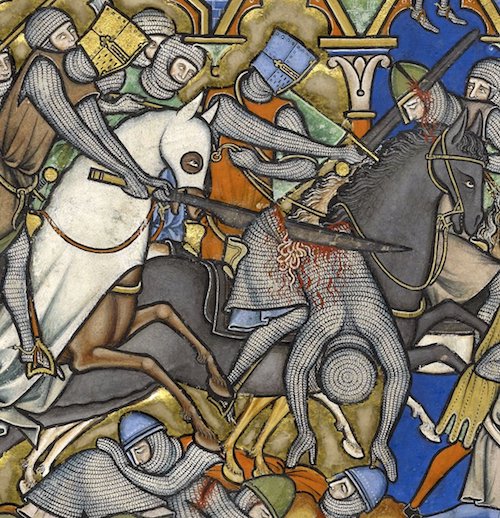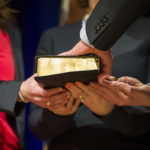We run our website the way we wished the whole internet worked: we provide high quality original content with no ads. We are funded solely by your direct support. Please consider supporting this project.

The Violent “Church Triumphant”
In light of how central enemy-loving non-violence is to Jesus’ teaching and to his cross-centered revelation of God, we have to wonder why the church has refused to listen to its head and instead condoned violence, as pointed out in the previous post? Christian theologians have used OT’s violent portraits of God, at least since fourth century to promote the use of violence. For example, how could Luther have failed to wrestle with the violent portraits of the Old Testament when he claimed to “see nothing in Scripture except Christ crucified”?
For the first three centuries of church history, theologians such as Origen found non-literal ways of interpreting the OT’s violent divine portraits so that they could not be used to promote violence. Christians during this period took seriously Jesus’ call to refrain from violence and to love and serve enemies. However beginning in the early fourth century, the church began to undergo a massive transformation.
It began when a Roman emperor named Constantine allegedly had a vision just before a major battle he was going to fight. This vision convinced him that he and his army would defeat their foes if he fought under the banner of Christ. This was the first (but unfortunately hardly the last) time the name of Jesus Christ was associated with violence. Constantine won the battle, and since pagans have always assumed that military victories reveal which army has the stronger god, Constantine decided to pledge his allegiance to Christ. However, his version of Christ was a triumphant pagan warrior deity rather than as the self-sacrificial loving Savior.
Constantine legalized Christianity in 313 A.D. and he showered the Church with wealth and political power. In the span of less than a century, the Church went from being a despised and persecuted minority within the Roman Empire to the official religion of the Roman Empire, making it illegal for everyone except Jews not to be a Christian. And since the religion of Rome had always played an important role in the running of the State, the Church began to play this role.
However, it’s impossible to play any role in running the Roman Empire (or any other empire for that matter) if you’re not willing to use the sword to preserve law and order and to protect the State from threatening foes. So, not surprisingly, in the fourth and fifth centuries we find Christian theologians like St. Augustine going to extreme lengths to try to justify the use of violence, despite the NT’s clear teachings to the contrary.
Whereas the persecuted Church of the first three centuries believed it was called to refrain from violence and serve the world by carrying the cross, the politically-empowered Church of the fourth and fifth centuries began to believe it was called to conquer the world for Christ, wielding the sword when necessary. The persecuted Church became the persecuting “Church Triumphant,” since it now had the political authority to persecute heretics and unbelievers. The Empire of Rome was retitled “the holy Roman Empire,” and Christ was believed to be its triumphant Emperor. “Christendom” was born, and while this religion has (thankfully) been dying for the last several hundred years, it has, for all intents and purposes, been the face of Christianity for the last fifteen hundred years.
As Christendom was coming into being, and Christians acclimated to the use of violence, the OT’s violent depictions of God became much less problematic. Indeed, it became advantageous at this time to interpret these portraits literally. Christendom’s leaders could appeal to them when they needed to justify their use of violence and when they needed to motivate Christians to engage in violence on behalf of their “Christian” Empire. Tragically, these violent portraits have been serving this function ever since.
Image: Fatality, ‘Maciejowski Bible’, Paris ca. 1240 (NY, Morgan Library & Museum, MS M.638, fol. 10v)
Category: General
Tags: Augustine, Constantine, Cruciform Theology, Jesus, Violence
Topics: Enemy-Loving Non-Violence, The Church
Related Reading

Two Questions to Unlock Violent Divine Portraits
There are two basic questions that help us to interpret what is going on in the violent portraits of God in the Old Testament, as I propose in Crucifixion of the Warrior God. The First Question: What does the “God-breathed” revelation of the cross teach us about the nature of God’s “breathing”? God “breathed” his…

The Centrality of Christ in Hebrews, Part 2
The intensely Christocentric reading of the Old Testament that I introduced in the previous post is reflected throughout the book of Hebrews. Here I want to cite two more examples of how this writer saw Christ at the center of the OT. Hebrews 7 Here the author argues for the superiority of Christ’s priesthood over…

Jesus Repudiates OT Commands on Oath-Taking: A Response to Paul Copan (#9)
In his critique of Crucifixion of the Warrior God (CWG), Paul Copan argues that “Boyd pushes too hard to make Jesus’ teaching appear more revolutionary than it really is” [italics original]. Whereas I argue that Jesus repudiates aspects of the Old Testament (OT), Copan argues that Jesus merely repudiates wrong applications of the OT, not…

The Greatest in the Kingdom (2 of 2)
Article by Natalie Frisk This post is a summary of what was discussed at the ReKnew CrossVision Conference in regard to what and how we teach our kids about the cruciform hermeneutic. Taking Jesus into the Old Testament I co-lead a family-friendly home church where we sometimes get into spiritually deep conversations with children. There…

How NOT to be Christ-Centered: A Review of God With Us – Part II
In Part I of my review of Scott Oliphint’s God With Us we saw that Oliphint is attempting to reframe divine accommodation in a Christ-centerd way. Yet, while he affirms that “Christ is the quintessential revelation of God,” he went on to espouse a classical view of God that was anchored in God’s “aseity,” not…

Why Bart Ehrman Doesn’t Have to Ruin Your Christmas (Or Your Faith) Part 2
This is the second of several videos Greg put together to refute Bart Ehrman’s claims published in the article What Do We Really Know About Jesus? If you missed it, you can catch the first installment here.
